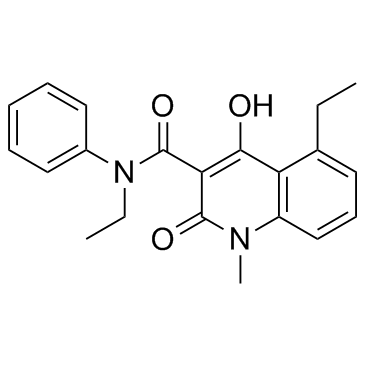| Cas No.: | 248282-01-1 |
| Chemical Name: | ABR 25757,ABR-25757,ABR25757,Paquinimod,248282-01-1 |
| Synonyms: | ABR 25757,ABR-25757,ABR25757,Paquinimod,248282-01-1 |
| SMILES: | O=C(C1=C(O)C2=C(C=CC=C2CC)N(C)C1=O)N(CC)C3=CC=CC=C3 |
| Formula: | C21H22N2O3 |
| M.Wt: | 350.41 |
| Sotrage: | 2 years -20°C Powder, 2 weeks 4°C in DMSO, 6 months -80°C in DMSO |
| Description: | Paquinimod is a S100A9 inhibitor, which prevents S100A9 binding to TLR-4. |
| In Vivo: | S100A9 is a calcium-binding protein of the S100 family. Paquinimod is an immunomodulatory compound preventing S100A9 binding to TLR-4. Prophylactic treatment with S100A9 inhibitor Paquinimod reduces pathology in experimental collagenase-induced osteoarthritis[1]. Paquinimod is a potent inhibitor of insulitis and diabetes development in the NOD mouse. To assess the preventive efficacy of Paquinimod on diabetes development in female NOD mice, groups of mice are treated with daily doses of 0.04, 0.2, 1, and 5 mg/kg/day of Paquinimod from week 10 of age until week 20 of age. Glycosuria is analyzed on a weekly basis from 10 weeks of age until the endpoint of the experiment at 40 weeks of age. There is a clear dose-dependent reduction in diabetes development in the Paquinimod-treated mice[2]. |

 DC Chemicals' products qualify for U.S. tariff exemptions. We guarantee no price increases due to customs duties and maintain stable supply, continuing to deliver reliable research solutions to our American clients.
DC Chemicals' products qualify for U.S. tariff exemptions. We guarantee no price increases due to customs duties and maintain stable supply, continuing to deliver reliable research solutions to our American clients.





















